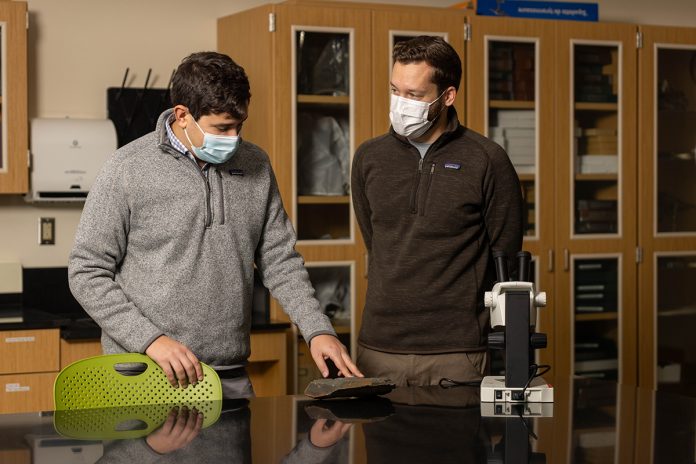It’s hard to imagine what Earth was like 360 million years ago when the late Paleozoic ice age began. It’s hard to visualize that, during that period, there were only two massive continents and that what is now Pennsylvania was below the equator.
And, with all the current debate about global climate change and warming, it’s almost hard to believe that the Earth today is experiencing icehouse conditions.
But researchers in Southern’s Earth Science Department are working to add focus and definition to the late Paleozoic ice age in an effort to better understand what is happening now and how human beings are influencing Earth’s atmosphere.
“It’s an interesting time period,” according to Earth Science Professor Nick Fedorchuk. “It’s significant because it is the last complete icehouse climate period before the one in which we are currently.”
An icehouse climate, which may include several glacial periods, is characterized by cooler temperatures, lower levels of atmospheric carbon dioxide (CO2), and glaciation at high and mid latitudes.
About 260 million years ago, Earth evolved into a greenhouse climate with more atmospheric CO2 and warmer temperatures. This climate period, concurrent with the Mesozoic era, included an explosion of life forms such as dinosaurs and flowering plants. It lasted until about 34 million years ago, when Earth once again transitioned to an icehouse climate.
Fedorchuk, along with student Eric Regan, traveled to Pennsylvania this past summer with a team that included researchers from Edgewood College in Wisconsin to examine evidence of sub-equatorial glaciers in the region.
Regan, a Fairfield resident who graduates from Southern this month, will present the findings of his independent study at the annual meeting of the Northeastern Section of the Geological Society of American in March 2022. The research helps bring clarity to exactly when and where glaciers existed all those millions of years ago.
“We tend to look at a map of earth during an ice age and draw a big red circle and say that was all glaciers,” Fedorchuk says. But the reality, he explains, is that glaciers are dynamic — advancing and receding over time.
So, the team looked for evidence of glaciers around Wilkes-Barre, Penn., where sedimentary rock provides a good record of geological history, and used different methods of examining their samples in order to narrow their findings.
During the late Paleozoic ice age, the Appalachian Mountains of Pennsylvania were located closer to the equator and are thought to have been similar in size to the modern Himalayas. As the movements of the mountains and glaciers occur, they leave behind evidence that can be observed and studied. The nature of glaciers in that region and in that time period is very much up for debate, according to Fedorchuk.
“Glaciers move like a giant plow, picking up things and depositing them in a giant rock bed,” Regan explains. “A debris flow, such as a mudslide or a volcanic eruption, deposits things in a different pattern.”
Regan’s initial observations seem to point away from widespread glaciation and more toward a sub-aqueous debris flow. But even the study of ancient rocks is subject to new technology, and Regan is awaiting results of chemical weathering tests on samples he collected.
Chemical weathering is another indicator of the presence or absence of glaciers, as the rock beneath a glacier would have been protected from weathering that would have altered its chemical make-up.
The samples Regan collected were sent to Michigan State University to undergo X-ray fluorescence testing, in which powdered rock samples are bombarded to reveal the elements present.
“I don’t want to oversell that there were ‘no glaciers,’” Fedorchuk says, noting that the scope of the research was limited to three sites. There are many unresolved questions, he says: Where were all the glaciers located, how widespread, what is the timing of the glaciers? And answering those questions may help us in the 21st century. The more we understand the characteristics of glaciers, the more accurately we can predict climate change now.
“What leads us out of an icehouse climate into a greenhouse climate is the rise in carbon dioxide,” he explains. During the last icehouse climate period, the proliferation of trees and forests pulled CO2 out of the atmosphere. But microbes had not yet evolved to decay the woody parts of the trees so eventually carbon-rich plants were converted into coal.
Ordinarily the rise of CO2 can happen as a result of volcanism, over millions of years. But currently the burning of fossil fuels, like coal, is releasing CO2 back into the atmosphere at a rate that is much faster than that of the last transition from an icehouse to greenhouse climate.
It’s why Fedorchuk and Regan believe it’s important to bring greater resolution to the picture of the late Paleozoic ice age. The more knowledge of that transition can help us compare to the current climate.
“We’re most definitely in a cyclical climate. It’s not a new thing; it’s always been happening,” Regan says. But based on the data of how quickly carbon is being reintroduced to the atmosphere, he adds, “it does seem that we are having some impact.”
Regan will go on to graduate school next year, turning his focus to planetary science. Fedorchuk will be conducting research in South America in summer 2022.


